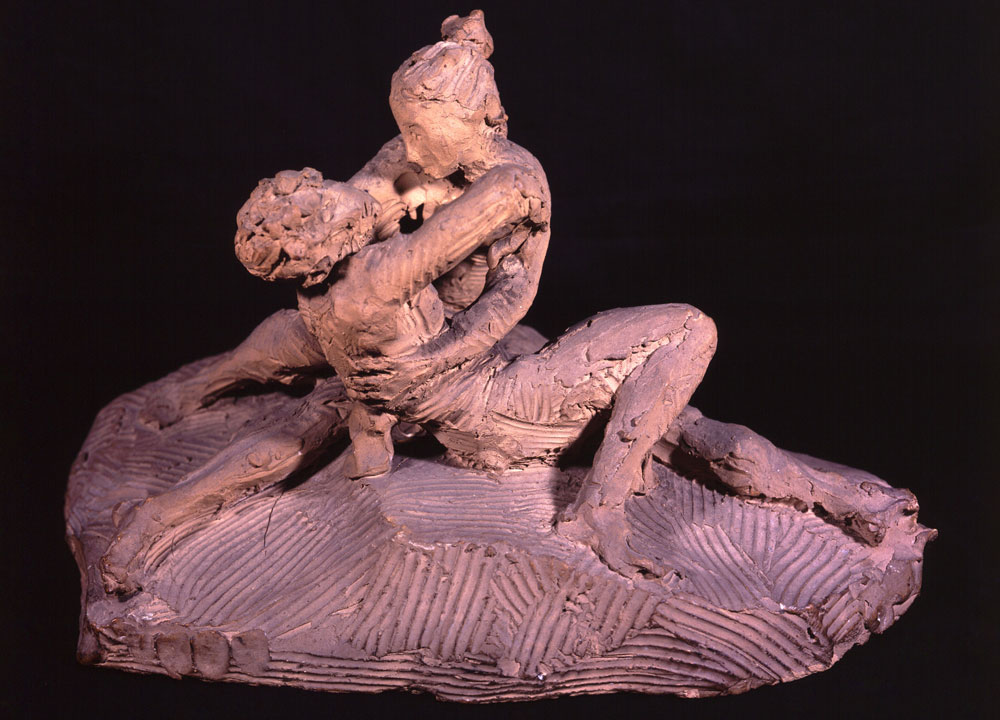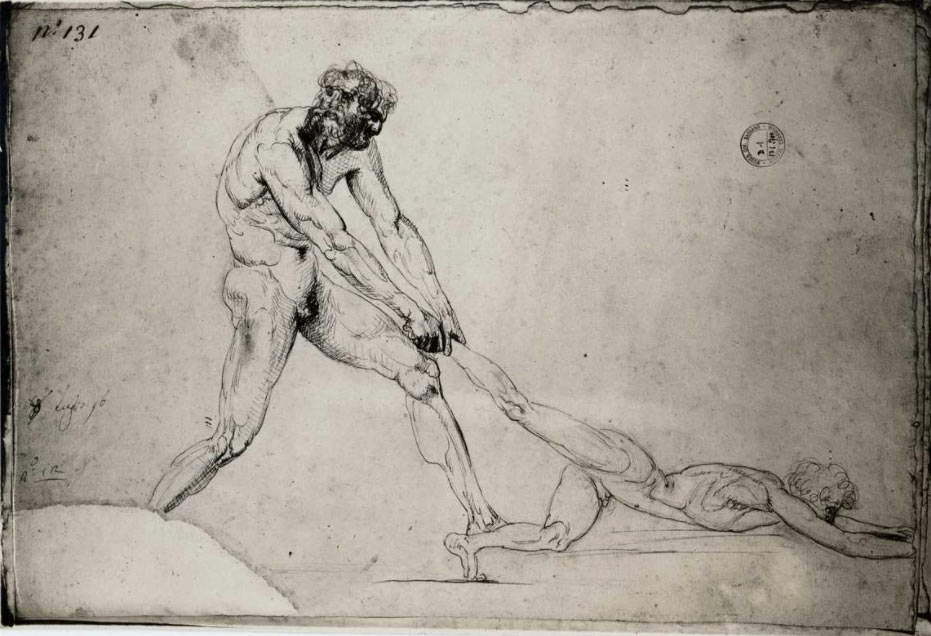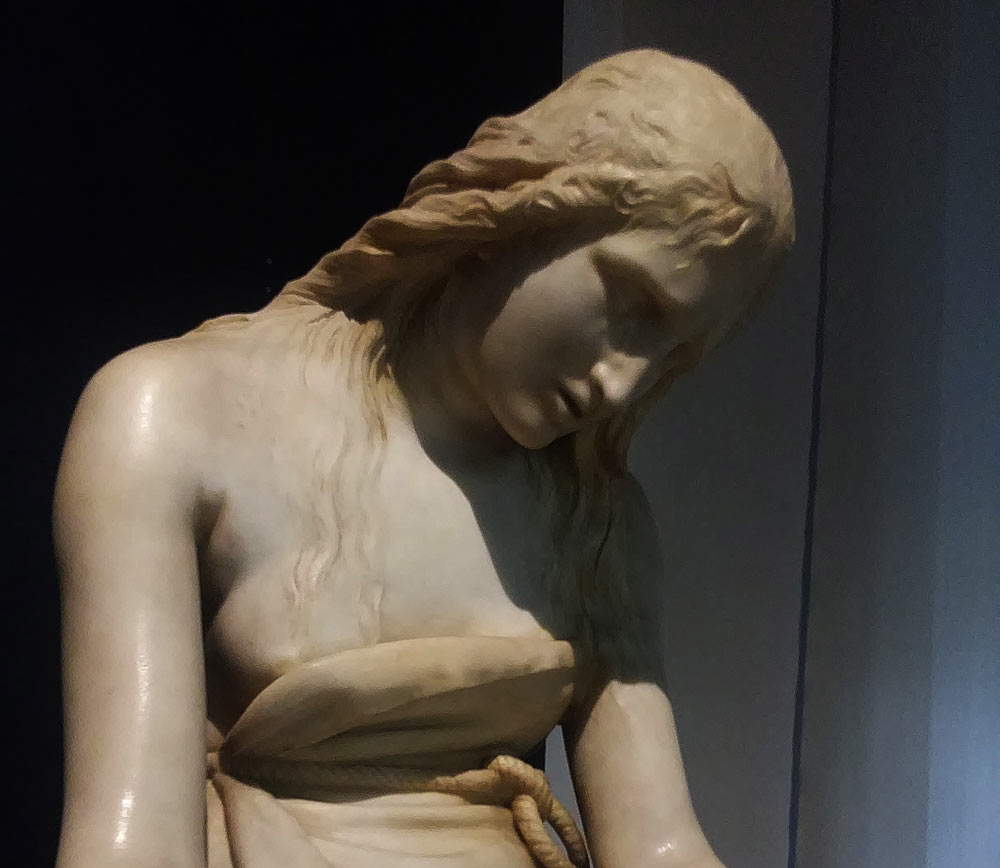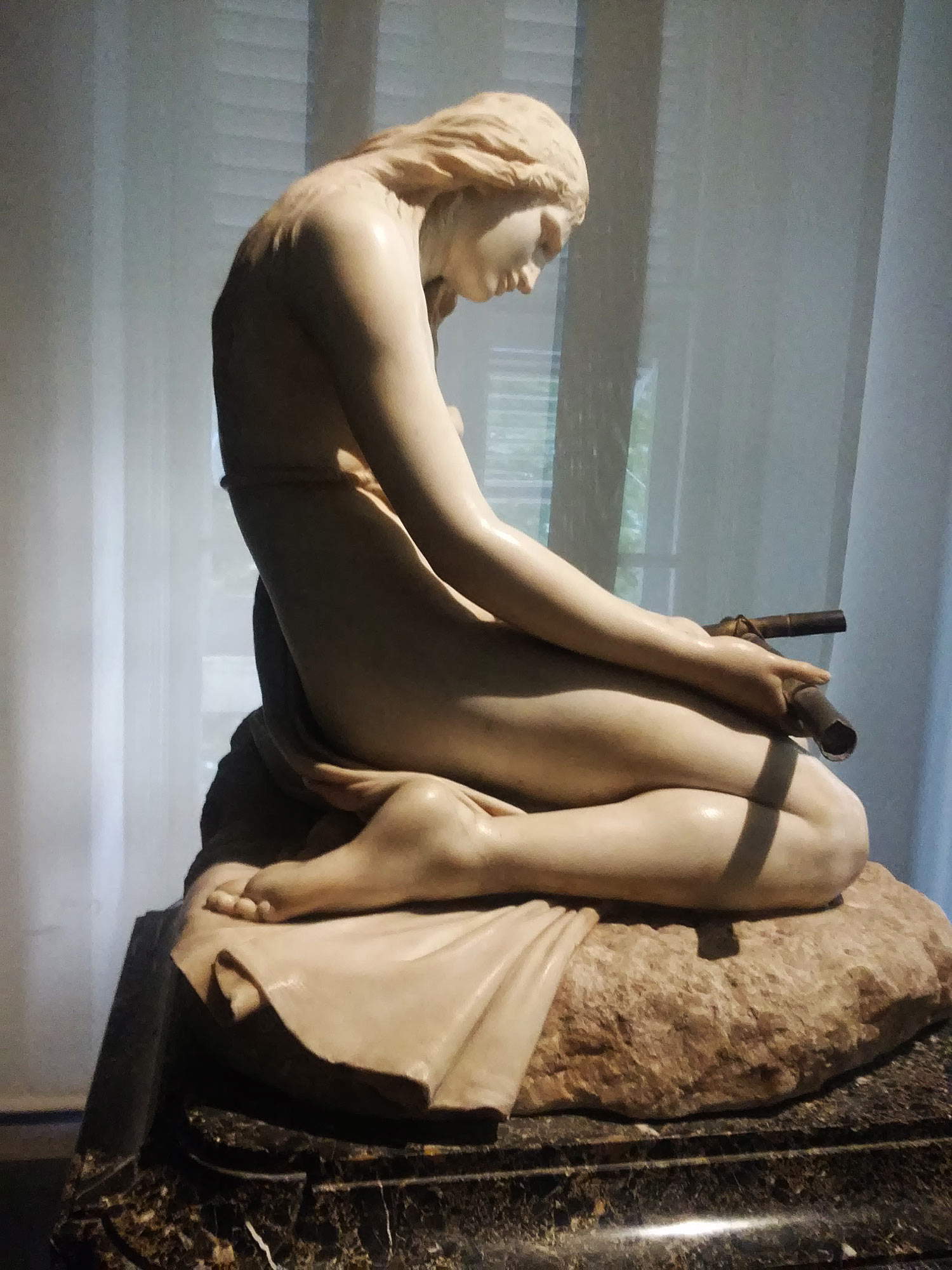“He rewrote the hierarchies between the divine and the human as only a ’demigod of the fable,’ a hero of mythical time could have done. ”1 This is how the French writer Stendhal, in his Life of Napoleon (1817-1818), sketches the figure of the father in Italian Neoclassicism: Antonio Canova (Possagno, 1757 - Rome, 1822).
Canova, originally from Possagno, in the province of Treviso, the son and grandson of stonecutters, grew up in an environment in which the step, drill, and chisel must have been decidedly familiar tools to him. When his father died, Antonio began his apprenticeship at the workshop of his paternal grandfather (“a valiant stonecutter not to say also Sculptor ”2) where he deepened his technical knowledge of the craft. His training took a further step when, as an apprentice, he was “apprenticed” to Giuseppe Bernardi, a member of one of the leading sculpture firms of the Serenissima.
Canova’s initial training, then, could be defined as purely sculptural, far, therefore, from the study and practice of drawing typical of the academic education he would receive only from 1770 onward at Ca’ Farsetti (or Galleria Farsetti) in Venice. As we shall see, however, these technical and formal aspects, acquired at a young age, would shape the Master’s artistic temperament, becoming elements of absolute uniqueness within his boundless artistic production.
The skillful use of technical and formal means, in fact, combined with the initial realization of sketches and study drawings, will lead him to create models first in terracotta and finally in plaster (life-size), which will allow him, in the last stage of production, to know how to handle marble to perfection.
The addition of a simple step, in fact, which was the creation of the terracotta sketch, allowed the artist (strong not of one, but of two previous models) to treat the marble in an almost mnemonic way and to be able to place, thus, attention to every single expressive, gestural, three-dimensional detail and, above all, to the rendering of the surfaces. A meditated, rational workmanship, therefore, made up of precise “stages,” which would see Canova coin a new, effective (and appreciated) modus sculpendi. The sketches, moreover, help us to understand how the master investigated the relationship between sculpture and the surrounding space, the latter perceived as a tangible, concrete, “oppressive” entity that, vibrating around the sculptures being modeled, enlivens them. Indeed, it is no coincidence that the wax models turn out to be “fast, fiery images, thoughts expressed with a frank immediacy ”3 (far from the elegant neoclassical conception), in a word: instinctive (fig. 1).
This investigation is even more strikingly supported by a vast production of sketches and preparatory drawings that would characterize much of Canova’s sculptural activity. Drawing, in fact, is understood by the Master as a tool capable of composing the image in all its aspects (form, contours, chiaroscuro) and, therefore, capable of bringing back to paper that impulse and those emotions that, inevitably, are aroused in us by the perception of any “thing,” human figure or object (figs. 2,3). This aspect, then, “has [no longer] its presuppositions in the classicist orthodoxy of Winckelmann [...] but in the figurative culture that we are used to define as preromantic, anchored in the concepts of the sublime and heroic, ”4 which fermented in Roman cultural circles at the end of the eighteenth century.5
The sketches and preparatory drawings, therefore, reveal to us in greater depth and detail Canova’s real artistic sensibility, allowing us to free him from the cloying and limiting role of an “artist [...] encapsulated in a superimposed style such as the Neoclassical one, ”6 in which formal problems were merely skimmed over.
 |
| 1. Antonio Canova, Sketch for Reclining Cupid and Psyche (1787; terracotta, height 25 cm; Venice, Museo Correr) |
 |
| 2. Antonio Canova, Bourgeois Gladiator (pencil, white chalk, rough ochre paper, 538 x 440 mm; Bassano del Grappa, Museo Civico) |
 |
| 3. Antonio Canova, Furious Hercules hurls Lica to the ground (1796; pen and pencil on paper, 323 x 459 mm; Bassano del Grappa, Museo Civico) |
All these innovative attentions, placed both in the technical-execution process and in the plastic and material rendering of the figures, emerge with absolute clarity in one of the most admired, desired andreplicated sculptures7 in all of Europe: the Penitent Magdalene of Genoa(fig. 4).
The Magdalene, following numerous and still cryptic changes of ownership that saw her, for more than a century (1776 - 1889), wander through the most important cities of’Europe (Rome, Milan, Paris), without an effective and stable owner, 8 it found, only at the threshold of the twentieth century, its definitive location in Genoa, where it was exhibited in 1892 “on the occasion of the Colombian celebrations. ”9 To this it should be added that detailed critical attention to this sculpture arrived, thanks to Franco Boggero, only in 1980: still forty years ago, in fact, Canova’s work was kept “in the deposits of Palazzo Rosso in Genoa ”10. La Maddalena, commissioned ab origine for Tiberio Roberti (1749-1817), “amatore passionatissimo delle belle arti, ”11 and finished as indicated by Canova himself on June 13, 179512, was exhibited to the general public for the first time in 1808 at the Paris Salon13 .
The sculpture caused an incredible stir, so much so that the director of the Imperial Museum stated how “We statuary admired the precise workmanship of the marble, the beautiful expression of the head, and the moving abandon of the pose. ”14 The strong sensuality of the figure and the face, suffering and contracted due to the long penitential fast, thanks to the highly refined execution technique dictated by the previous wax and plaster sketch studies (fig. 5), are brought to an extreme outcome, so much so that they are able to vivify the intimate suffering of the sinner.
 |
| 4. Antonio Canova, Penitent Magdalene (1793-1796; marble and gilded bronze, 95 x 70 x 77 cm; Genoa, Musei di Strada Nuova, Palazzo Bianco, rooms in Palazzo Tursi) |
 |
| 5. Antonio Canova, Penitent Magdalene (1793-1796; marble and gilded bronze, 95 x 70 x 77 cm; Genoa, Musei di Strada Nuova, Palazzo Bianco, rooms in Palazzo Tursi) |
 |
| 6. Antonio Canova, Penitent Magdalene, detail |
Suffering that is even more explicit (in addition to the skull, symbol of Vanitas) by the woman’s face, which, marked by subtle and almost imperceptible rivulets of tears, refers with its “alienation” to an otherworldly dimension: divine forgiveness (fig. 6). The hair, from which a few strands of hair descend along the shoulders, laps at the limits of the drooping, clumped robe that accompanies, without an apparent solution of continuity, the woman’s placid abandonment.
The idea of abandonment and exhaustion (dictated by the sinner’s redemption) are, moreover, accentuated by the exhausted arms that, placed in the act of contemplation, seem to wearily support the plummeting torso. The sweetness and chiaroscuro effects of her flesh are rendered through a “mixture of wax and sulfur” that, used to treat the marble surface (evident in the yellowing of the sculpture), allows for a masterful rendering of the woman’s epidermal naturalness (figs. 7,8). This contrivance, along with the bronze cross in Magdalene’s hands (the only non-marble element in the sculpture), can be considered a true “pictorial expedient, ”15 stemming from Canova’s (a painter as well as a sculptor) attention to Correggio’s luminous and plastic language; of interest for future analysis, the Magdalene in his Noli me tangere (figs. 9,10) might turn out to be.
With the Magdalene (with features so neoclassical of Winckelmanian noble simplicity and quiet grandeur but with absolutely protoromantic expressive power) “the idea of the marble under the scarpello [so much so that] it seems to see in it the variety of tints and their gradations, and the last skin, and fatness and life ”16: the idea of Bello.
 |
| 7. Antonio Canova, Penitent Magdalene, detail |
 |
| 8. Antonio Canova, Penitent Magdalene, detail |
 |
| 9. Correggio, Noli me tangere (c. 1525; oil on panel transported on canvas, 130 x 103 cm; Madrid, Prado) |
 |
| 10. Correggio, Noli me tangere, detail |
Notes
1 L. Mascilli Migliorini, Il tempo storico e il tempo mitico di Antonio Canova, in Canova l’invenzione della gloria: disegni, dipinti, sculture, Roma, 2016, pp. 27.
2 H. Honour, From the sketch to the <last hand>, in Antonio Canova, Venice, 1992, p. 33.
3 A. Giuliano, Antonio Canova: notes for a critical biography, Canova l’invenzione della gloria: disegni, dipinti, sculture, Roma, 2016, p. 60.
4 F. Leone, Canova and the Roman neoclassical avant-garde, in Canova l’invenzione della gloria: disegni, dipinti, sculture, Roma, 2016, p. 47.
5 The same circles to which Canova, in 1779, was introduced by his patrons: Prince Abondio Rezzonico and the Venetian ambassador to the Holy See Gerolamo Zulian.
6 Giuliano, 2016, p. 59.
7 In addition to the Magdalene of the Hermitage, there are: The plaster of the Civic Museums of Padua, that of the Fine Arts of Carrara, Brera, Venice, Turin, and Bologna: see G. Ericani, Maddalena penitente (1790 and 1809-10), in Canova l’invenzione della gloria: disegni, dipinti, sculture, Roma, 2016, p. 255.
8 See C. Di Fabio, Canova’s La Maddalena: commissions and owners, virtual and real (1790-1806), in Canova l’invenzione della gloria: disegni, dipinti, sculture, Roma, 2016, pp. 281-290.
9 C. Olcese Spingardi, Traces of Canova’s influence in Genoa from neoclassicism to eclecticism, in Canova the invention of glory: drawings, paintings, sculptures, Rome, 2016, p. 277 (note 5).
10 F. Boggero, Una rilettura critica del Canova: la “Maddalena penitente,” in Arte lombarda, n.s., no. 55/56/57, 1980. p. 386.
11 Di Fabio, 2016, p. 282.
12 Ericani, 2016, p. 253.
13 The statue, in that year, was purchased by its penultimate owner, the Lombard lawyer Giovanni Battista Sommariva and transported to his Parisian villa: Di Fabio, 2016, p. 287.
14 Boggero, 1980, p. 390.
15 Boggero, 1980, p. 390.
16 Ericani, 2016, p. 254.
Warning: the translation into English of the original Italian article was created using automatic tools. We undertake to review all articles, but we do not guarantee the total absence of inaccuracies in the translation due to the program. You can find the original by clicking on the ITA button. If you find any mistake,please contact us.